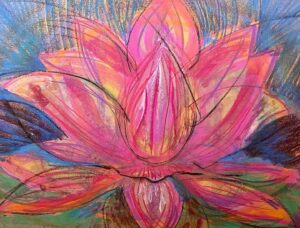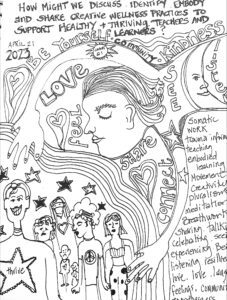HOW MIGHT WE DISCUSS, IDENTIFY, EMBODY AND SHARE CREATIVE WELLNESS PRACTICES TO SUPPORT HEALTHY AND THRIVING TEACHERS AND LEARNERS?
and this is WHY we need to…
It was the middle of the month of September 2022 and we were attending our first special assembly in two years, on the important topic of Truth and Reconciliation. There were hundreds of us: teachers, staff, administrators and students from grades 9 to 12, sitting close together in rows, in the dark theater. I glanced to my right at the girl sitting next to me and I could see and feel her legs shaking, her hands shaking, really trembling. I made eye contact, offering an empathic glance to let her know I was there and could see her struggling. I instinctively put my hand on her back and whispered, “I’m right here with you. Hey, let’s look for 5 things in this room that look nice, now let’s see if we can smell anything, now let’s listen”. I was drawing on my recollection of a grounding exercise we had learned about, but it wasn’t working as she was still shaking and even harder than before. The speaker continued to talk about difficult experiences which further added to the intensity of the moment. Instinctively, I pulled my sketchbook out of my bag as well as black sharpie. I opened the book to a fresh page and passed it over to her. “Just watch yourself draw slowly”, I whispered, “start to make little repetitive marks over and over, and slow your breath to match the mark making”. At first, her hands were very shaky, and she had to really push the marker on the paper to stabilize her hand. All her focus turned to the activity of drawing, and I could feel a slight relaxation start to emerge as the shaking of her legs slowed. Not wanting to draw attention to us, I continued giving her instructions but this time by writing directives on my iPad. I wrote: Think of a container you can create that will be able to hold this discomfort, and when you are ready draw it. Now, imagine this discomfort can be put inside it. Create a lid that you can use to close the container.

Student drawing to self regulate in a public space
Write some positive affirmations around your container to remind yourself of your own strength, like I am. I watched as she added ‘I can, I feel, I love’ around the jar she had created on the page. I continued to write: Now start to draw calm shapes, words and support around your container. She continued to draw, and draw, and I could see her becoming noticeably calmer. After about 15 minutes of drawing, there was no more shaking. With a sense of certainty in her actions, she stopped abruptly, looked at the sketch, closed the book and sharpie, and looked me in the eyes, and said, “Thank you!”. She handed me my book “You can keep it”, she smiled. I whispered, “By the way, what you just did is called therapeutic art, remember that it is always available to you”. As we made our way out of the auditorium she shared that each mark she had drawn outside of the container, was a thought she had in her head. I said: “Wow, that’s a lot of thoughts, no wonder you were feeling overwhelmed! But now look at all the space you’ve created for yourself around the bottle”. We parted ways. As I made my way to my class, I noticed I was surprised by the encounter and thankful for my recent art therapy residency because, without saying much, without doing a whole lot, I was able to support a student to regulate her physiology using a sketchbook and a marker in a very public crowded space.
This situation I have just described, of a student experiencing significant panic at school, happens more than we’d like to acknowledge. The reality is that our kids are really struggling. Pre-pandemic, the statistics showed that 1 in 7 teens, on any given day, were experiencing significant mental health issues, predominantly with anxiety and depression. Moreover, 70% of these young people would not get support for their mental health. Knowing that over the pandemic, the number of teens seeking mental health support grew by 30% both in requests for help and emergency hospital visits; there was a 60% increase in the number of youth reporting eating disorders; and Canada’s youth suicide rate is the third highest in the industrialized world (Youth Mental Health Stats in Canada 2022). We are experiencing a crisis in youth mental health, and I believe an all-hands-on deck approach is required. Since my initial summer training at the Vancouver Art Therapy Institute, additional art therapy courses over this term, and with the success of the auditorium intervention under my belt, I could start to see that I have the ability to make a difference right now. I can use therapeutic art therapy tools in my course by integrating these activities into my art classes to support regulation, safety and relationship building.
The effectiveness of art interventions across all age groups is recognized in scientific research. In 2019, the World Health Organization (WHO) released the HEALTH EVIDENCE NETWORK SYNTHESIS REPORT 67, which synthesized evidence from over 3000 studies supporting the positive impact of the arts on health-related factors and conditions. The report called for the implementation of community arts programs for mental health as well as the development of interventions that encourage arts engagement to promote healthy lifestyles. It is past due that we are mindful about what activities we set up for adolescents, for the environments we create for them have a direct impact on how their brains develop as it is based on their experiences. Mihaly Csikszentmihalyi shared: “It is how people respond to stress that determines whether they will profit from misfortune or be miserable.” (Csikszentmihalyi , 7) As a result, we can wire them up to be high strung, or we can teach them wellness skills. I know that I am seeing an overwhelming number of kids that are not equipped to manage what we are expecting them to. I have decided that I can no longer wait for changes to come from educational leadership. I have decided to intervene using art tools and I can already see it is having an impact. I look forward to sharing some of the discoveries I am making in future blog posts.
Bibliography
Csikszentmihalyi, M. (2008). Flow: the psychology of optimal experience. 1st Harper Perennial Modern Classics ed. New York, Harper Perennial.
Elbrecht C. & Malchiodi C. A. (2018). Healing trauma with guided drawing : a sensorimotor art therapy approach to bilateral body mapping. North Atlantic Books.
Fancourt D, Finn S. What is the evidence on the role of the arts in improving health and well-being? A scoping review [Internet]. Copenhagen: WHO Regional Office for Europe; 2019. (Health Evidence Network synthesis report, No. 67.) Available from: https://www.ncbi.nlm.nih.gov/books/NBK553773/
Youth Mental Health Stats in Canada. Youth Mental Health Canada. (2022, February 13). Retrieved December 24, 2022, from https://ymhc.ngo/resources/ymh-stats/







